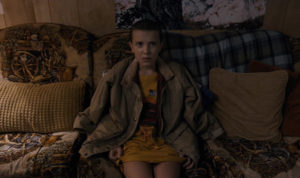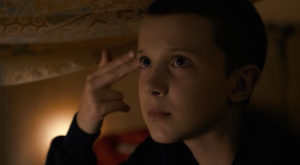 Only two episodes into Stranger Things and there’s really only one question to ask: are you hooked yet? You are, admit it. Or, if you’ve already finished the series, you can probably point to this episode as the one where the series fully wrapped its claws around you. Where Chapter One set you up in the eerie world of Hawkins, Indiana in 1983, Chapter Two solidified your new obsession by raising the stakes higher and firmly drawing the battle lines in the sand.
Only two episodes into Stranger Things and there’s really only one question to ask: are you hooked yet? You are, admit it. Or, if you’ve already finished the series, you can probably point to this episode as the one where the series fully wrapped its claws around you. Where Chapter One set you up in the eerie world of Hawkins, Indiana in 1983, Chapter Two solidified your new obsession by raising the stakes higher and firmly drawing the battle lines in the sand.
The same clutches grasp the inhabitants of Hawkins as well. In this episode, the vanishing of Will Byers becomes far more complex for all players involved. His mom Joyce is at the beginning of what seems like grief-stricken madness to most, Chief Hopper’s veil of normalcy is fully broken with the death of Benny and all the growing clues, and our dynamic trio of Lucas, Dustin, and Mike get much more than they bargained for from “the weirdo” with a number for a name. The journey grows more treacherous with each passing moment for these characters. Yet at the same time the hope also seems to grow.
That’s part of the hook that draws us as viewers. There’s a spirit of hope surrounding all of these events. It’s like a hand to hold as we follow the horror. On the surface, things seem dire, but the outlooks of both Mike and Joyce in particular are positive in their own ways. The story ahead may seem scary, but it feels like we’re going to make it through somehow. You’ll be on the edge of your seat and your fingernails might not survive, but in the end there’s a beacon. So we, like Joyce, steel up ourselves and head back into the house to see what awaits us in this story.
Said house is haunted, let me tell you. Shadowy creatures with giant head-mouths full of sharp teeth, lights blinking and buzzing everywhere, and curious breathing on the other end of the phone? That’s some other worldly stuff with a ton of “nope!” written all over it. But face it we must if we’re to solve these mysteries. So what do we do? Well, the thing about haunted houses is that when inside of them, good and evil becomes pretty apparent. It doesn’t necessarily make it less scary, but when we understand what is darkness and light, we can formulate a way out.
The most talked about aspect of this show is its 1980’s nostalgia. No doubt that every pop culture reference is wholly satisfying, but the show isn’t just left to that. Stranger Things touches so many nerves for the same reason that we pine for the days of the 80s. Generally speaking, good and evil were less gray back then, bad guys were clear, and heroes triumphed often. So we pine not just for Rubik’s cubes and synthesizers, but for the safety of familiarity. And Stranger Things delivers that.
 Who is after Eleven? “Bad men.” What do they want to do to her, Mike, and anyone in their way? Kill them. The unknown force that has taken Will and Barb and lurks in the shadows? It has no veiled motives; it only seeks to destroy. The way is clear- defeat these evils and survive. The parallel of Dungeons and Dragons is perfectly played. What seems just a game for kids mirrors real life struggles we face daily. The show accentuates this and shows us that while things can often seem so gray and so complex in our life, there is still a clear good and a clear evil.
Who is after Eleven? “Bad men.” What do they want to do to her, Mike, and anyone in their way? Kill them. The unknown force that has taken Will and Barb and lurks in the shadows? It has no veiled motives; it only seeks to destroy. The way is clear- defeat these evils and survive. The parallel of Dungeons and Dragons is perfectly played. What seems just a game for kids mirrors real life struggles we face daily. The show accentuates this and shows us that while things can often seem so gray and so complex in our life, there is still a clear good and a clear evil.
Think back to an imaginary game you played as a child. Whether it was something like setting up tea for your stuffed animal friends (I freely admit to doing this very thing) or imagining you were slaying a dragon (I also did this), remember the feeling you had during the game. There was a sense of safety to it, wasn’t there? Even if the dragon bared its fangs and spit its flames at you, in the end it was just a tall lamp in your grandmother’s house you were pretending was your foe. That’s what Stranger Things taps into. And I’m playing along.

